Replace the battery - EF300 and EF600
 Suggest changes
Suggest changes


You can replace a battery in an EF300, EF600, EF300C, or EF600C storage system.
Each controller canister includes a battery that preserves cached data if the AC power fails. If the Recovery Guru in SANtricity System Manager reports either a Battery Failed status or a Battery Replacement Required status, you must replace the affected battery.
-
Verify that no volumes are in use or that you have a multipath driver installed on all hosts using these volumes.
-
Review the Requirements for EF300 or EF600 battery replacement.
-
Make sure you have the following:
-
The replacement battery.
-
An ESD wristband, or other antistatic precautions.
-
A flat, static free work area.
-
Labels to identify each cable that is connected to the controller canister.
-
A management station with a browser that can access SANtricity System Manager for the controller. (To open the System Manager interface, point the browser to the controller's domain name or IP address.)
-
Step 1: Place controller offline
Back up data and place the affected controller offline.
-
From SANtricity System Manager, review the details in the Recovery Guru to confirm that there is an issue with a battery and to ensure no other items must be addressed first.
-
From the Details area of the Recovery Guru, determine which battery to replace.
-
Back up the storage array's configuration database using SANtricity System Manager.
If a problem occurs when you remove a controller, you can use the saved file to restore your configuration. The system will save the current state of the RAID configuration database, which includes all data for volume groups and disk pools on the controller.
-
From System Manager:
-
Select .
-
Select Collect Configuration Data.
-
Click Collect.
The file is saved in the Downloads folder for your browser with the name, configurationData-<arrayName>-<dateTime>.7z.
-
-
-
If the controller is not already offline, take it offline now using SANtricity System Manager.
-
Select Hardware.
-
If the graphic shows the drives, select Show back of shelf to show the controllers.
-
Select the controller that you want to place offline.
-
From the context menu, select Place offline, and confirm that you want to perform the operation.
If you are accessing SANtricity System Manager using the controller you are attempting to take offline, a SANtricity System Manager Unavailable message is displayed. Select Connect to an alternate network connection to automatically access SANtricity System Manager using the other controller.
-
-
Wait for SANtricity System Manager to update the controller's status to offline.
Do not begin any other operations until after the status has been updated. -
Select Recheck from the Recovery Guru, and confirm that the OK to remove field in the Details area displays Yes, indicating that it is safe to remove this component.
Step 2: Remove controller canister
Replace the failed battery with a new one.
-
Put on an ESD wristband or take other antistatic precautions.
-
Label each cable that is attached to the controller canister.
-
Disconnect all the cables from the controller canister.
To prevent degraded performance, do not twist, fold, pinch, or step on the cables. -
Confirm that the Cache Active LED on the back of the controller is off.
-
Squeeze the handles on either side of the controller, and pull back until it releases from the shelf.
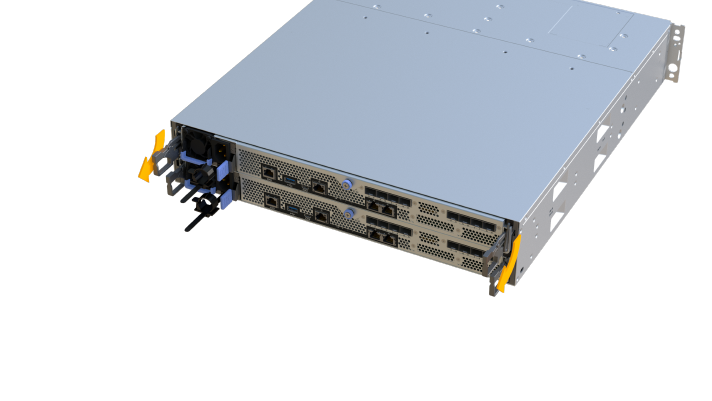
-
Using two hands and the handles, slide the controller canister out of the shelf. When the front of the controller is free of the enclosure, use two hands to pull it out completely.
Always use two hands to support the weight of a controller canister. 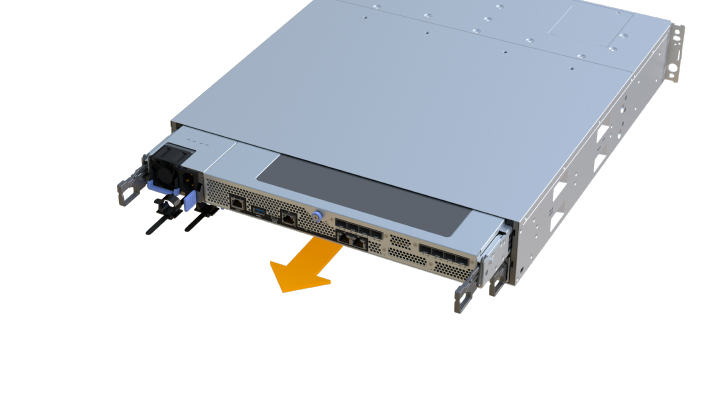
-
Place the controller canister on a flat, static-free surface.
Step 3: Remove failed battery
Pull the failed battery out of the controller.
-
Remove the controller canister's cover by unscrewing the single thumbscrew and lifting the lid open.
-
Confirm that the green LED inside the controller is off.
If this green LED is on, the controller is still using battery power. You must wait for this LED to go off before removing any components.
-
Locate the 'press' tab on the side of the controller.
-
Unlatch the battery by pressing the tab and squeezing the battery casing.
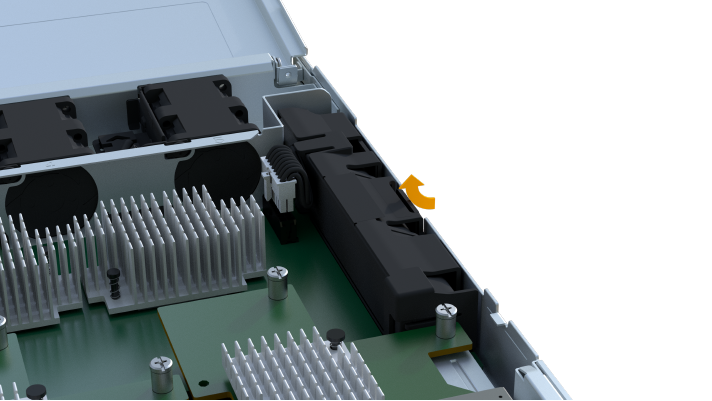
-
Gently squeeze the connector housing the battery wiring. Pull up, disconnecting the battery from the board.
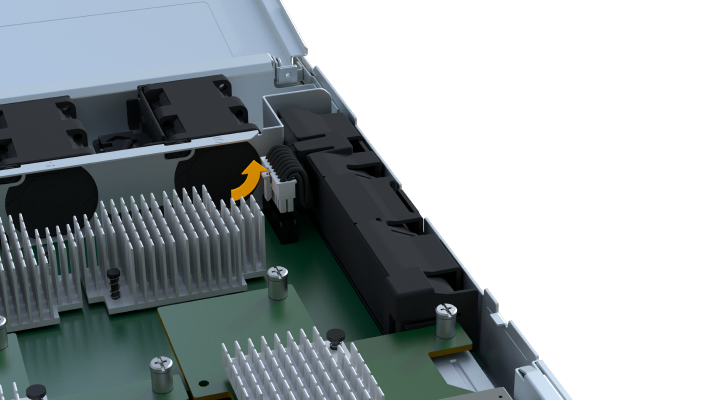
-
Lift the battery out of the controller and place on a flat, static-free surface.
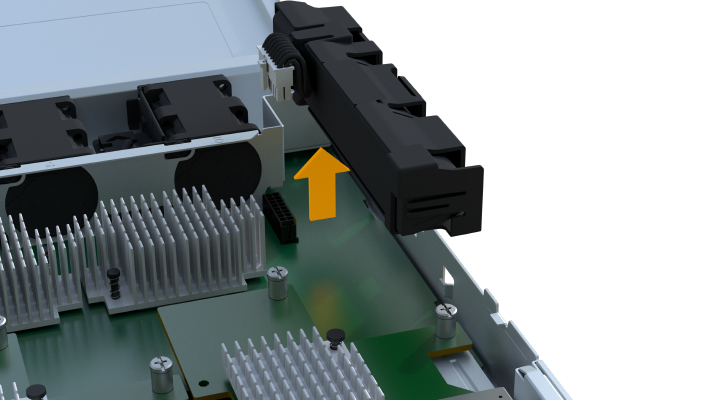
-
Follow the appropriate procedures for your location to recycle or dispose of the failed battery.
To comply with International Air Transport Association (IATA) regulations, never ship a lithium battery by air unless it is installed within the controller shelf.
Step 4: Install new battery
After you have removed the failed battery from the controller canister, follow this step to install the new battery.
-
Unpack the new battery, and set it on a flat, static-free surface.
To comply with IATA safely regulations, replacement batteries are shipped with a state of charge (SoC) of 30 percent or less. When you reapply power, keep in mind that write caching does not resume until the replacement battery is fully charged and it has completed its initial learn cycle. -
Insert the battery into the controller by lining up the battery casing with the metal latches on the side of the controller.

The battery clicks into place.
-
Plug the battery connector back into the board.
Step 5: Reinstall controller canister
Reinstall the controller into the controller shelf.
-
Lower the cover on the controller canister and secure the thumbscrew.
-
While squeezing the controller handles, gently slide the controller canister all the way into the controller shelf.
The controller audibly clicks when correctly installed into the shelf. 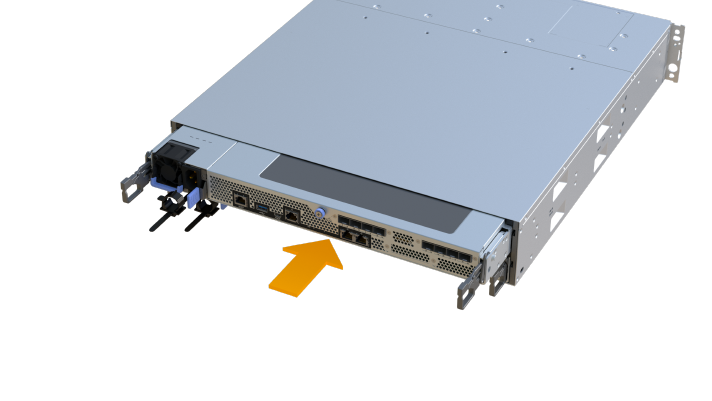
Step 6: Complete battery replacement
Place the controller online, collect support data, and resume operations.
-
Place controller online.
-
In System Manager, navigate to the Hardware page.
-
Select Show back of controller.
-
Select the controller with the replaced battery.
-
Select Place online from the drop-down list.
-
-
As the controller boots, check the controller LEDs.
When communication with the other controller is reestablished:
-
The amber Attention LED remains on.
-
The Host Link LEDs might be on, blinking, or off, depending on the host interface.
-
-
When the controller is back online, confirm that its status is Optimal and check the controller shelf's Attention LEDs.
If the status is not Optimal or if any of the Attention LEDs are on, confirm that all cables are correctly seated, and the controller canister is installed correctly. If necessary, remove and reinstall the controller canister.
If you cannot resolve the problem, contact technical support. -
Click to ensure that the latest version of SANtricity OS is installed.
As needed, install the latest version.
-
Verify that all volumes have been returned to the preferred owner.
-
Select . From the All Volumes page, verify that volumes are distributed to their preferred owners. Select to view volume owners.
-
If volumes are all owned by preferred owner continue to Step 6.
-
If none of the volumes are returned, you must manually return the volumes. Go to .
-
If only some of the volumes are returned to their preferred owners after auto-distribution or manual distribution you must check the Recovery Guru for host connectivity issues.
-
If there is no Recovery Guru present or if following the recovery guru steps the volumes are still not returned to their preferred owners contact support.
-
-
Collect support data for your storage array using SANtricity System Manager.
-
Select .
-
Select Collect Support Data.
-
Click Collect.
The file is saved in the Downloads folder for your browser with the name, support-data.7z.
-
Your battery replacement is complete. You can resume normal operations.




